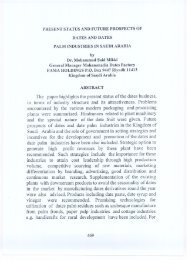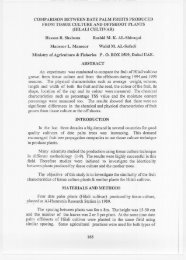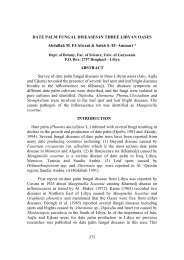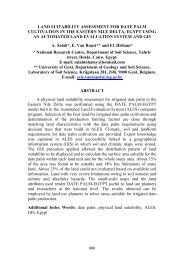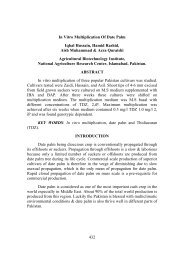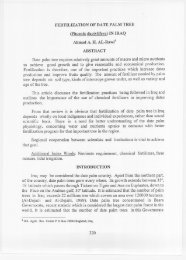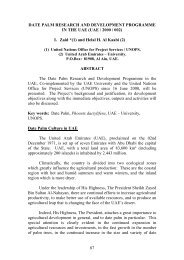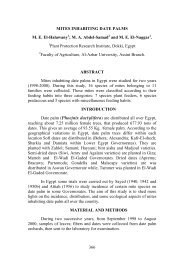Susceptibility of some date-palm cultivars to the root ... - Pubhort.org
Susceptibility of some date-palm cultivars to the root ... - Pubhort.org
Susceptibility of some date-palm cultivars to the root ... - Pubhort.org
Create successful ePaper yourself
Turn your PDF publications into a flip-book with our unique Google optimized e-Paper software.
SUSCEPTIBILITY OF SOME DATE-PALM CULTIVARS TO THEROOT-KNOT NEMATODE, MELOIDOGYNE INCOGNITAEissat, M.F..; EI-Sherier, M.A.; AbdeI Gawadt,M.M., YoussefM.M.A!.;Ismailt,A. A. and EI-Nagdi1,W.M.A.1. Nema<strong>to</strong>logy unit, Plant Pathology Dept., National Research centre.2. Nema<strong>to</strong>logy Dept., Fac. Agric.; Cairo Univ.ABSTRACTSeventeen <strong>date</strong>-plam <strong>cultivars</strong> were screened <strong>to</strong> determine <strong>the</strong> effect <strong>of</strong><strong>the</strong> tested <strong>date</strong>-<strong>palm</strong> seedlings on development and reproduction <strong>of</strong> Meloidoyneincognita. The nema<strong>to</strong>de development and reproduction varied according <strong>to</strong> <strong>the</strong>tested cultivar. Zanati was <strong>the</strong> only immune cultivar as nema<strong>to</strong>de infestation didnot survive on its <strong>root</strong>s. Six highly resistant <strong>cultivars</strong>; Aynat, Malakabi, Orabi,Sakkoti, Samani and Seqii were recorded in this study. O<strong>the</strong>r <strong>cultivars</strong>presented different degrees <strong>of</strong> resistance. Production <strong>of</strong> phenols and/orinhibi<strong>to</strong>ry hormones and/or <strong>to</strong>xins <strong>to</strong> <strong>the</strong> parasitizing nema<strong>to</strong>des are probablyresponsible <strong>of</strong> resistance mechanism in early growth stage <strong>of</strong> <strong>date</strong>-plam.INTRODUCTIONThe world produce 4.4 Million <strong>to</strong>ns <strong>of</strong> <strong>date</strong> (FAO, 1997) 97.1% <strong>of</strong> <strong>the</strong>World <strong>date</strong> production are from Arabian and Islamic countris. Date-plam is no<strong>to</strong>nly valuable as economic and social aspects; but also it is documented inrelegions, his<strong>to</strong>ry and arts.Several nema<strong>to</strong>de pests were recorded as parasites <strong>to</strong> <strong>date</strong>-plam <strong>root</strong>scausing losses in <strong>the</strong> early stage <strong>of</strong> growth (Nurseries). The <strong>root</strong>-knotnema<strong>to</strong>des, Meloidogyne spp. are <strong>some</strong> <strong>of</strong> <strong>the</strong> most comon wide-spreadnema<strong>to</strong>des all-over <strong>the</strong> World (Sasser, 1989).These pests act as endoparasitesand have hundreds <strong>of</strong> hosts under field conditions.Few studies have been conducted on host reaction <strong>of</strong> <strong>date</strong>-plam <strong>cultivars</strong><strong>to</strong> detect <strong>the</strong>ir relative susceptibility <strong>to</strong> <strong>root</strong>-knot nema<strong>to</strong>de species. Carpenter(1964) tested 50 <strong>date</strong>-<strong>palm</strong> <strong>cultivars</strong> against Meloidogynejavanica infection.The <strong>cultivars</strong> Braim, Hayany and Honey were rated as susceptible <strong>cultivars</strong> <strong>to</strong><strong>the</strong> nema<strong>to</strong>des, but Amhat and Deglet Noor were ranked as <strong>to</strong>lerant <strong>to</strong>nema<strong>to</strong>de infection. Lamberti and Greco (1977) reported that four <strong>cultivars</strong> <strong>of</strong><strong>date</strong>-<strong>palm</strong>, Le., Bou Feggous, Kabkab, Medijool and Deglet Noor, werescreened for resistance <strong>to</strong> three populations <strong>of</strong> both Meloidogyne incognita andM javanicap. Deglet Noor cultivar was generally rated as poor host <strong>to</strong>nema<strong>to</strong>de infection. Griffth and Koshy (1990) stated that young seedlings <strong>of</strong> 50<strong>date</strong>-<strong>palm</strong> <strong>cultivars</strong> were susceptible <strong>to</strong> infection by <strong>root</strong>-knot nema<strong>to</strong>de.Moreover, 90% <strong>of</strong> <strong>the</strong> tested seedlings were killed prior <strong>to</strong> emergence whens~edsweresownin heavlyinfectedsoil.282------------- - --- -
The present article investigates <strong>the</strong> susceptibility <strong>of</strong> 17 <strong>date</strong>-<strong>palm</strong><strong>cultivars</strong>, at <strong>the</strong>ir early stage <strong>of</strong> growth, <strong>to</strong> M incognita.MATERIALS AND METHODSUnder greenhouse conditions, 17 <strong>date</strong> <strong>palm</strong> <strong>cultivars</strong> were screened <strong>to</strong>M incognita infection. The tested <strong>cultivars</strong> were Aglani, Amhat, Aynat, Bent-Eisha, Gondela, Hayany, Malakabi, Orabi, Saidi, Sakkoti, Samani, Seqii,Shamya, Sokarya, Wardy, Zaghlool and Zanati. Seeds <strong>of</strong> each cultivar weresoaked in renewable tap water for one week, <strong>the</strong>n incubated in wetted clothfor two weeks. Sprouted seeds were planted in 20 cm diameter clay pots filledwith sterilized sandy loam soil. Two weeks later, five replicates from eachcultivar were inoculated with 200 newly hatched purified M incognitalarvae/pot. O<strong>the</strong>r five non inoculated pots from each cultivar kept as untreatedcontrol. The pots were watered regularily for 10months.Nema<strong>to</strong>de extraction followed Jenkins (1964) technique. Nema<strong>to</strong>decounting was done by 1 ml Hawksley eclworm counting slide. Nema<strong>to</strong>deidentification followed (Mai & Lyon,1975).Roots were stained for fur<strong>the</strong>r examination (Franklin and Goodey,1949).Data were recorded for number <strong>of</strong> <strong>root</strong> galls (G), developing larvae stages(D.S.), females (F) and egg-laying females (E.F.) per <strong>root</strong> system wereestimated. Rate <strong>of</strong> nema<strong>to</strong>de penetration, maturation, reproduction, potentialeggmassesproduction,potentialpopulationdensity,rate<strong>of</strong> susceptibilityandbuild-upwerecalculatedaccording<strong>to</strong> <strong>the</strong> followingformula(Oostenbrink,1966):--Rate <strong>of</strong> penetration (R.P.) =- Rate <strong>of</strong> maturation (R.M.)=Count <strong>of</strong> <strong>to</strong>tal nema<strong>to</strong>des in <strong>root</strong> tissuesCount <strong>of</strong> neme<strong>to</strong>des used for inoculationTotal count <strong>of</strong>females+egg-Iaving femalesTotal count <strong>of</strong> nema<strong>to</strong>des in <strong>the</strong> <strong>root</strong> tissuesXlOOXlOO-Rate <strong>of</strong> reproduction (R.R.)= Count<strong>of</strong>egglayingfemales X100Total count <strong>of</strong> females +egg-Iaying females- Potential eggmasses production (P.E.P.)= Number<strong>of</strong>eggmasses/cultivar X100Number <strong>of</strong> eggmasses/potential cultivar-Potential population density (P.Pop.)= Totalfinalpopulationlcultivar XIOOTotalfinalpuplation<strong>of</strong> potentialcultiver-Rate <strong>of</strong> susceptibility (R.S.)= Average <strong>of</strong>P.E.P.+P.pop.-Rate <strong>of</strong> build up (R.B.)= To~a.1final counts <strong>of</strong> neme<strong>to</strong>des in r~ot and .soil(Pr) XIOOInItial count <strong>of</strong> nema<strong>to</strong>de used for inoculation (Pi)RESULTS AND DISCUSSION<strong>Susceptibility</strong> <strong>of</strong> seventeen <strong>date</strong>-<strong>palm</strong> <strong>cultivars</strong> <strong>to</strong> M incognita wastested. Data on number <strong>of</strong> galls, nema<strong>to</strong>de developmental stages, rates <strong>of</strong>reproduction and population build-up were recorded, ten months after <strong>the</strong>inoculation (Tables 1-3). Host susceptibility or resistance rates were alsodeterimned (Table 4). Reactions <strong>to</strong> M incognita infection differed remarkablyamong <strong>date</strong>-<strong>palm</strong> <strong>cultivars</strong>. Aglani, Bent-Eisha and Zaghlool <strong>cultivars</strong> showed<strong>the</strong> highest M incognita <strong>root</strong> gall index <strong>of</strong> four (Table 2). While, Aynat andMalakabi had <strong>the</strong> lowest index <strong>of</strong> 1.2. The o<strong>the</strong>r <strong>cultivars</strong> showed moderate283-- -- -- - ----
oot-gall indices. Zaghlool cultivar supported <strong>the</strong> highest M. incognita rate <strong>of</strong>build-up comparing <strong>to</strong> cultivar Orabi which showed <strong>the</strong> lowest rate (Table 3).Based on number, relative number <strong>of</strong> galls, developmental larval stages, matureand egg-laying females host susceptibility <strong>of</strong> <strong>cultivars</strong> was determinedaccording <strong>to</strong> Hadisoeganda and Sasser (1982). The average <strong>of</strong> <strong>the</strong>aforementioned rates for each cultivar defmed its host suitability category <strong>to</strong>nema<strong>to</strong>de infection (Table 4). In this respect, <strong>cultivars</strong> Aglani, bent-Eisha andZaghlool were rated as highly susceptible and <strong>cultivars</strong>; Amhat, Hayany andSlkarya were considered moderately susceptible. On <strong>the</strong> o<strong>the</strong>r hand, <strong>cultivars</strong>Aynat, Malakabi, Orabi, Saidi, Sakkoti, Samani and Seqii were categorized ashighly resistant. The most promising cultivar was Zanati which proved <strong>to</strong> beimmune <strong>to</strong> <strong>the</strong> tested M incognita population. The nema<strong>to</strong>de population densityin soil were generally not always in consistence with <strong>the</strong>ir densities in <strong>the</strong> <strong>root</strong>system.Growth response <strong>of</strong> <strong>date</strong>-<strong>palm</strong> <strong>cultivars</strong> <strong>to</strong> infection with Meloidogyneillcognita:The impact <strong>of</strong> M incognita infection on <strong>the</strong> growth <strong>of</strong> 17 <strong>date</strong>-<strong>palm</strong><strong>cultivars</strong> was studied. data on number <strong>of</strong>leaves, lengths and weights <strong>of</strong> bothshoots and <strong>root</strong>s were recorded (Table 5). It is obvious that growth <strong>of</strong> all plantswas greatly affected by <strong>the</strong> nema<strong>to</strong>de infection. The reduction in number <strong>of</strong>leaves <strong>of</strong> most inoculated plants was not significant except for cv. Zaghloolwhich was 20.9%. The shoot length <strong>of</strong> all inoculated plants was notsignificantly different from uninoculated plants except for cvs. Aglani, Bent-Eisha and Saidi which were 27.5, 16.4 and 20.8% reduction, respectively. Theshoot fresh weight reduction in all inoculated <strong>cultivars</strong> were not significantexcept for cvs. Amhat, Aynat, Shamya and Wardy which were 33.9,34.4,21.8and 20.7% reduction, respectively. Shoot dry weight in all inoculated <strong>cultivars</strong>were not significantly different from control plants except for Amhat, Aynat,Bent-Eisha and Malakabi which showed reduction <strong>of</strong> 28.9, 32.9, 21.5 and16.4%, respectively. On <strong>the</strong> o<strong>the</strong>r hand, <strong>root</strong> length <strong>of</strong> most inoculated <strong>cultivars</strong>were significantly different from respective checks. However, reduction in <strong>root</strong>fresh weight and dry weight <strong>of</strong> most inoculated <strong>cultivars</strong> was not significantexcept for <strong>cultivars</strong> Aglani and Zaghlool.Results indicated that most <strong>of</strong> <strong>the</strong> examined <strong>date</strong>-<strong>palm</strong> <strong>cultivars</strong> wereinfected with M incognita. The tested <strong>cultivars</strong>, however, varied in <strong>the</strong>irsuitability as hosts <strong>to</strong> this nema<strong>to</strong>de pest. They were classified in<strong>to</strong> five groupsstarting from immune <strong>to</strong> highly susceptible. Immune and resistant <strong>date</strong>-<strong>palm</strong><strong>cultivars</strong> may be cosidered <strong>the</strong> most economical components for M incognitamanagement. In this respect, one immune cultivar, Zanati, and six highlyresistant <strong>cultivars</strong>; Aynat, Malakabi, Orabi, Sakkoti, Samani and Seqii wereidentified in <strong>the</strong> present study. The resistant <strong>cultivars</strong> probably produce phenols,enzymes, inhibi<strong>to</strong>ry hormones and/or <strong>to</strong>xins <strong>to</strong> nema<strong>to</strong>de which prevent itsdevelopment.284
LITERATURE CITED- Carpenter, J.B. (1964). Root-knot nema<strong>to</strong>de damage <strong>to</strong> <strong>date</strong>-<strong>palm</strong> seedlingsin relation <strong>to</strong> germination and stage <strong>of</strong> development. Date Growers Inst.,Ann. Rept., 44: 10-14- FAO (1997). Agricultural Statistics <strong>of</strong> 1996.FAO Rome.- FrankIin, M.T. and J.B. Goody (1949). A cot<strong>to</strong>nblue-lac<strong>to</strong>phenoltechniquefor mounting plant-parasitic nema<strong>to</strong>des. 1.Helmin<strong>to</strong>l., 23: 175-178.- Griffth, R. and P.K. Koshy (1990). Nema<strong>to</strong>de parasites <strong>of</strong> coconut ando<strong>the</strong>r <strong>palm</strong>s. In: Plant Parasitic Nema<strong>to</strong>des in Subropical and TropicalAgriculture (M. Luc, R.A. Sikora and J. Bridge(eds.). C.A.B. International,363-386.- Hadisoeganda, W.W. and J.N. Sasser (1982). Resistance <strong>of</strong> <strong>to</strong>ma<strong>to</strong>, bean,sou<strong>the</strong>rn pea and garden pea <strong>cultivars</strong> <strong>to</strong> <strong>root</strong>-knot nema<strong>to</strong>des based on hostsuitability. Plant Disease, 66: 145-150.- Jenkins, W.R. (1964). A rapid centrifugal flotation technique for separatingnema<strong>to</strong>des from soil. PI. Dis. Reptr. 18:692. "- Lamberti, F. and E.N. Greco (1977). Pathogenicity <strong>of</strong> two species <strong>of</strong>Meloidogyne on four varieties <strong>of</strong> <strong>date</strong>-<strong>palm</strong>.Nema<strong>to</strong>l.Medit., 5: 159-172.- Mai, W.F. and H.H. Lyon (1975). Pic<strong>to</strong>rial key <strong>to</strong> genera <strong>of</strong> plant-parasiticnema<strong>to</strong>des. Ithaca, CorneIIUniversity Press, 220 p.- Oostenbrink, M. (1966). Major characteristics <strong>of</strong> <strong>the</strong> relation between nema<strong>to</strong>desand plants.Meded.Landbouwhogesch,Wageningen,66-4, 46 pp.- Sasser, J.N. 1989 Plant Pavasitic Nema<strong>to</strong>des, <strong>the</strong> fanner's Hidden Enery.Bull. PI. Path. Dept. N.C. state Univ., pp. 115.285- -
Table (1): Number <strong>of</strong> Me/oidogyne incognita developmental stages onseventeen <strong>date</strong>-<strong>palm</strong> <strong>cultivars</strong> +.No. <strong>of</strong> developmental stages / <strong>root</strong>Cultivars 2nd 3 rd 4th Mature Totallarvae larvae larvae femalesEggmassesAglani 2529 6 26 317 2878 102bcAmhat 426 13 48 183 670 30 cdeAynat 0 0 0 3 3 1 eBent- 1036 127 194 755 2112 262 aEishaGondela 0 75 33 55 163 24 deHayany 569 4 20 194 787 84 bcdMalakabi 0 7 7 16 30 10 deOrabi 0 3 4 5 12 5eSaidi 0 18 15 58 91 14 deSakkoti 332 4 4 17 357 12 deSamani 21 20 12 34 87 15 deSeqii* 0 6 . 2 14 22 8 deShamya 469 96 43 128 736 48 cdeSokarva* 2123 57 42 116 2338 83 bcdWardy 0 119 74 100 293 35 cdeZaghlool 2437 5 36 361 2839 145bZanati 0 0 0 0 0 0+ Means <strong>of</strong> 5 replicates.+ Cultivars from Saudi Arabian origin.- Data in columns followed by a common letter are not significantly different (P0.05) accoridng <strong>to</strong> Duncan's multiple range test (DMRT).286- - -- -
Table (2): Number <strong>of</strong> Meloidogyne incognita galls, second stage in soil, <strong>to</strong>talnema<strong>to</strong>de in <strong>root</strong> system and gall index on <strong>date</strong>-<strong>palm</strong> cuItivars+.CultivarsNo. <strong>of</strong> 2nd TotalNo. <strong>of</strong>stage in nema<strong>to</strong>deTotalRoot-gallgalls persoil per stages in index<strong>root</strong>plant <strong>root</strong> systemAglani 2387# a 2882 a 5269 51 b 4.0Amhat 805 de 680 b 1485 26 cd 3.2Aynat 195 g 3g 198 2h 1.2Bent-Eisha 2422 ab 2119 a 4541 64 a 4.0Gondela 527 def 163 d 690 5th 2.0Hayany 1279 bcd 792 b 2071 45 b 3.8Malakabi 158 th 30 f 188 3h 1.2Orabi 53 g 12 h 65 10 eth 2.2Saidi 0 94 e 94 16 def 2.1Sakkoti 42 g 357 c 399 25 cd 2.0Samani 122h 89 e 211 17 de 2.2Seqii* 48 g 22 f 70 9 eth 2.2Shamya 256 eth 736 b 992 11 eth 2.4Sokarya* 1026 cde 2338 a 3364 32 c 3.4Wardt 431 def 293 cd 724 15 def 2.3Zaghlool 2990 abc 2843 a 5833 56 ab 4.0Zanati 0 0 0 0 0.0+ Values are means <strong>of</strong>5 replicates.* Cultivars from Saudi Arabian origin.# Final nema<strong>to</strong>de population/pot containing 2 kg soil where <strong>the</strong> initial nema<strong>to</strong>depopulation. Were 200 larave/pot.Data in columns followed by a common letter are not significantly different(P 0.05) according <strong>to</strong> Duncan's multiple range test (DMRT).287- - -- -- - - - -
Table (3): Nema<strong>to</strong>de development and reproduction on <strong>date</strong>-<strong>palm</strong> <strong>cultivars</strong>infected with <strong>root</strong>- knot nema<strong>to</strong>de, Meloidogyne incognita.Rate <strong>of</strong> Rate <strong>of</strong> Rate <strong>of</strong> Rate <strong>of</strong>. +Cultivars penetratIon maturation+ reproduction+ build-up +(RP. ) (RM. ) lRR)Aglani 1650.5 12.7 75.7 28.4Amhat 446.5 23.9 8?9 9.2 .Aynat 3.5 57.1 75.0 1.03Bent-Eisha 1568.0 32.4 74.2 27.8Gondela 121.0 32.6 69.6 3.8Hayany 534.5 25.9 69.8 11.7Malakabi . 28.0 46.4 61.5 1.1Orabi 11.0 45.5 50.0 0.4Saidi 83.0 43.4 80.6 0.8Sakkoti 193.0 7.9 58.6 2.1Samani 69.0 35.5 69.4 1.3Seqit 22.0 50.0 63.6 0.5Shamya 456.0 19.3 72.7 5.8Sokarya . 1268.5 7.8 58.3 17.8Wardy 214.5 31.5 74.1 4.3Zaghlool 1679.0 15.1 71.3 31.7Zanati 0.0 0.0 0.0 0.0+ As indicated in materials methods.· Cultivars fi:omSaudi Arabian origin.288- - -- - ----
Table(4): Reproduction and population density <strong>of</strong> Meloidogyne incognita on 17 <strong>date</strong>-<strong>palm</strong><strong>cultivars</strong>. . -Cultivars D.S MF E.M NUS T.F.P RP R.M RR PE.P P.Pop Fac<strong>to</strong>r R.SAglani 2882 317 102 2387 5688 1650.5 12.7 24.3 38.90 89.7 64.3 HSAmhat 680 183 30 805 1698 446.5 23.9 14.5 11.50 26.8 19.2 M.RAynat 3 3 1 195 205 3.5 57.1 25.0 0.38 3.2 1.8 HRBent-Eisha 2119 755 262 2422 5558 1568 32.4 25.8 100.00 87.7 93.9 HSGondela 163 SS 24 527 769 121 32.6 30.4 9.20 12.1 10.7 M.RHayany 792 194 84 1279 2349 534.5 25.9 30.2 32.10 37.1 34.6 MSMa1ak.1bi 30 16 10 158 214 28 46.4 38.5 3.80 3.4 3.6 HROrabi 12 5 5 53 75 11 45.5 50.0 1.90 1.2 1.6 HRSaidi 94 58 14 - 166 83 43.4 19.4 5.30 2.6 3.9 HRSakkoti 357 17 12 42 428 193 7.9 41.4 4.60 6.8 5.7 HRSamani 89 34 IS 122 260 69 35.5 30.6 5.70 4.1 4.9 HRSeqii 22 14 8 48 92 22 50 36.4 3.10 1.5 2.3 HRShamya 736 128 84 256 1168 456 19.3 27.3 18.10 18.4 18.3 M.RSokarya 2338 116 83 1026 3563 1268.5 7.8 41.7 31.70 56.2 43.9 MSWardyI 294100 35 431 860 214.5 31.5 25.9 13.40 13.6 13.5 M.RZaghlooI 2842/ 361Zanati -D.S. = Developmental 5'...:igeT.F.P.= Total firu:I. pop:.!lation.M.F.=~facure female R.P.= Rate <strong>of</strong> productionE..M.=EggmassR.M.= Rate <strong>of</strong> maturation~1JS = NO.<strong>of</strong>larvae in soil R.R= Rate <strong>of</strong> reproduction.HR 1-10 %M.R 10-20 %MS. 20-50 %H.S. >50 %I-145 2990 6338 1674 15.1 28.7 55.30 100.0 77.7 HS- - - - - - - - 0.0P .E.P= Potentia! egg mass productionP.Pop= Potential populationR.S.= Rate <strong>of</strong> susceptibility/mm....289------- -- -
#(-)8 :lJ1d.l:lUIC \,; lallL "IU"""" 1'-.;)U\r,,,U_ .........-.--.--... __._-_&&JI ""............. Mall .....-..............,.. ..-.-._- .-- ----- .--- ....-...........- -Shoot groWth +. Root groWth+Cultivars . No.oC leaves L.:ngth Fresh weight Dryweight Length Fresh weight Dry weight(cm) (gm) (gm) (Cmt- (gm) (gm)AgfaniCon. !nt: Con. In£. Coo. In£. Con. In£. "Con: . -Tnf. Con. In£. Con. 1n1:5 4 42.0 29.68 3.9 3.8 1.5 1.4 63.0 32.88 4.6 3.9 1.90 1.38(20) (27.5) (3.5) (6.9) (47.7) (14.4) (:4.9)Amhat 4 4 31.4 27.S 6.7 4.18 2.3 1.78 60.8 %8.6" 3.1 4.5 1.10 1.50Aynat(-) ( 11.5) (33.9) (26.1) (52.3) (-) (-).5 5 35.2 33.S 5.9 3.88 2.3 1.58 41.2 43.2 2.6 2.9 0.94 1.07Bent-Eisha 6 5I 37.0GondelaHayanyMalakabiOrabi(-) (4.9) (34.4) (32.9) (-) (-) (-)33.8' 6.S 6.3 2.2 1.8" 67.0 3S.S" 3.4 5.9 1.03 1.60(20) (16.4) (3.2) (21.5) (43.1) (0) (-)4 5 32.0 36.2 8.4 8.8 2.4 2.4 40.0 44.0 3.7 5.2 1.50 1.40(-) (-) (0) (0) (0) (0) (6.7)5 5 31.8 33.S . 6.04 7.2 2.3 2.4 57.0 36.Q" 4.04 6.7 1.50 I.SUI(-) (0) (-) (-) (40.2) (-) (-). -4 4 3004 33.6 6.5 5.5 2.3 2.18 49.4 41.2" 2.9 4.1 1.04 1.2(-) (-) (15.4) (1604) (19.1) (-) (-)4 4 21.4 20A 3.7 3.6 1.4 1.5 5004 43.20 4.2 4.2 1.20 1.40(-) (6.7) (3.7) (0) (14.3) (-) (5.0)Saidi 4 4 40.6 31.88 4.1 4.04 1.6 lA 58.8 31.S" 3.3 3.5 1.20 UI (-) (20.8) ( 1.5) (13.5) (43.6) (-) (-)SakkotiSamaniSeqiiShamyaSokaryaWardyZaghloolIIIII4I4 30.S 29.4 3.08 4.5 1.18 1.58 21.0 34.4 2.7 4.2 1.06 1.6(-) (4.5) (-) (0) (0) (-) (-)4 4 40A 35.8 5.90 5.7 2.1 2.0 66.2 41.28 2.6 2.9 1.08 1.35I(-) ( 11.4) (3.7) (4.8) (34.2) (-) (-)5 29.2 28.0 5.3 6.7 2.1 2.4 47.6 42.4 3.7 3.9 1.5 1.6(-) (4.1) (-) (0) (10.9) (-) (0)6 6 37.6 37.2 9.4 7.5 2.8 2.3 54.6 48 4.2 5.5 1.4 1.9'--I(-) (1.1) (21.8) (17.9) (12.1) (-)I (-j5 4 20.8 20.8 5.1 4.8 1.9 2.02 59.0 41.9" 2.2 2.3 1.0 1.8(20) (-) (5.9) (0) (23.9) (-) (-)5 4 30 34.4 5.8 4.5' 2.2 I.S 47.4 36.2" 2.9 3.7 1.06 1.5(20) (-) (20.7) (18.2) (24.4) (-) (-)7 5' 35.8 31.8 11.5 9.6 3.2 2.8 85.2 30A" 6.9 4.5' 2.3 1.3'(20.9) ( 13.2) (17.6) ( 13.8) (64.4) (37.8) (oI3.)Zanaci 4 4 19.5 19.8 2.8 2.8 1.2 1.3 59.0 62.0 2.4 2.6 1.4 1.5(-) (-) (-) (-) (-) (-) (-)Values are me:lJ1S<strong>of</strong> 5 replicates.Figures in paren<strong>the</strong>sis indicated <strong>the</strong> percentage <strong>of</strong> reduction over <strong>the</strong> check pl:lJ1ts... indicate <strong>the</strong> signific:lI1t 41l1dhighly signifiC41l1tat p =0.05 and 0.01. respectively.290----------------



